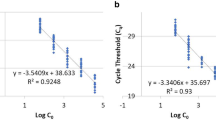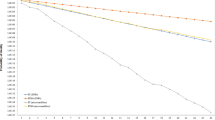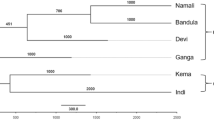Abstract
Wildlife crimes and the threats they present to elephant populations raise the need to develop and implement DNA-based methodology as an aid for wildlife forensic investigations and conservation efforts. This study describes the development of a tetra-nucleotide repeat STR multiplex, genotyping assay that will identify Asian elephant (Elephas maximus) and African elephant (Loxodonta africana) DNA. The assay targets six tetra-nucleotide STRs and two sex-typing markers simultaneously in both genera of elephants, a first for elephant genotyping assays. The developed assay has potential application in wildlife investigations to associate a biological sample to a particular individual elephant and additionally in conservation science for population management.



Similar content being viewed by others

References
Wasser SK, Brown L, Mailand C, Mondol S, Clark W, Laurie C, Weir BS (2015) Genetic assignment of large seizures of elephant ivory reveals Africa’s major poaching hotspots. Science 349:84–87. https://doi.org/10.1126/science.aaa2457
Hughes CR, Queller DC (1993) Detection of highly polymorphic microsatellite loci in a species with little allozyme polymorphism. Mol Ecol 2:131–137. https://doi.org/10.1111/j.1365-294X.1993.tb00102.x
Rassmann K, Schlötterer C, Tautz D (1991) Isolation of simple-sequence loci for use in polymerase chain reaction-based DNA fingerprinting. Electrophoresis 12:113–118. https://doi.org/10.1002/elps.1150120205
Butler JM (2005) Forensic DNA typing: biology, technology, and genetics of STR markers. Burlington, MA: Elsevier Academic Press
Archie EA, Moss CJ, Alberts SC (2003) Characterization of tetranucleotide microsatellite loci in the African Savannah elephant (Loxodonta africana africana). Mol Ecol Notes 3:244–246. https://doi.org/10.1046/j.1471-8286.2003.00412.x
Fernando P, Vidya TNC, Melnick DJ (2001) Isolation and characterization of tri- and tetranucleotide microsatellite loci in the Asian elephant, Elephas maximus. Mol Ecol Notes 1:232–233. https://doi.org/10.1046/j.1471-8278.2001.00082.x
Wasser SK, Joseph Clark W, Drori O et al (2008) Combating the illegal trade in African elephant ivory with DNA forensics. Conserv Biol 22:1065–1071. https://doi.org/10.1111/j.1523-1739.2008.01012.x
Wasser SK, Shedlock AM, Comstock K, Ostrander EA, Mutayoba B, Stephens M (2004) Assigning African elephant DNA to geographic region of origin: applications to the ivory trade. Proc Natl Acad Sci U S A 101:14847–14852. https://doi.org/10.1073/pnas.0403170101
Ahlering MA, Hailer F, Roberts MT, Foley C (2011) A simple and accurate method to sex savannah, forest and Asian elephants using noninvasive sampling techniques. Mol Ecol Resour 11:831–834. https://doi.org/10.1111/j.1755-0998.2011.03030.x
Vallone PM, Butler JM (2004) AutoDimer: a screening tool for primer-dimer and hairpin structures. Biotechniques 37:226–231. https://doi.org/10.2144/04372ST03
Conte J, Potoczniak MJ, Tobe SS (2018) Using synthetic oligonucleotides as standards in probe-based qPCR. BioTechniques 64:177–179. https://doi.org/10.2144/btn-2018-2000
Conte J, Potoczniak MJ, Mower C, Tobe SS (2019) ELEquant: a developmental framework and validation of forensic and conservation real-time PCR assays. Mol Biol Rep 46:2093–2100. https://doi.org/10.1007/s11033-019-04660-7
Bustin, SA (2004). AZ of quantitative PCR. La Jolla, CA: International University Line
Henegariu O, Heerema NA, Dlouhy SR, Vance GH, Vogt PH (1997) Multiplex PCR: critical parameters and step-by-step protocol. Biotechniques 23:504–511. https://doi.org/10.2144/97233rr01
Bregu J, Conklin D, Coronado E, Terrill M, Cotton RW, Grgicak CM (2013) Analytical thresholds and sensitivity: establishing RFU thresholds for forensic DNA analysis. J Forensic Sci 58:120–129. https://doi.org/10.1111/1556-4029.12008
Ishida Y, Demeke Y, de GPJ v C et al (2012) Short amplicon microsatellite markers for low quality elephant DNA. Conserv Genet Resour 4:491–494. https://doi.org/10.1007/s12686-011-9582-5
Nyakaana S, Okello JBA, Muwanika V, Siegismund HR (2005) Six new polymorphic microsatellite loci isolated and characterized from the African savannah elephant genome. Mol Ecol Notes 5:223–225. https://doi.org/10.1111/j.1471-8286.2005.00885.x
Wozney KM, Wilson PJ (2012) Real-time PCR detection and quantification of elephantid DNA: species identification for highly processed samples associated with the ivory trade. Forensic Sci Int 219:106–112. https://doi.org/10.1016/j.forsciint.2011.12.006
Gugala NA, Ishida Y, Georgiadis NJ, Roca AL (2016) Development and characterization of microsatellite markers in the African forest elephant (Loxodonta cyclotis). BMC Res Notes 9(364):364. https://doi.org/10.1186/s13104-016-2167-3
Suwattana D, Jirasupphachok J, Kanchanapangka S, Koykul W (2010) Tetranucleotide microsatellite markers for molecular testing in Thai domestic elephants (Elephas maximus indicus). Thai J Vet Med 40:405–409
Kinuthia J, Harper C, Muya S, Kimwele C, Alakonya A, Muigai A, Gakuya F, Mwaniki M, Gatebe E (2015) The selection of a standard STR panel for DNA profiling of the African elephant. Conserv Genet Resour 7:305–307. https://doi.org/10.1007/s12686-014-0366-6
Chakraborty R, Kimmel M, Stivers DN, Davison LJ, Deka R (1997) Relative mutation rates at di-, tri-, and tetranucleotide microsatellite loci. Proc Natl Acad Sci 94:1041–1046. https://doi.org/10.1073/pnas.94.3.1041
Ellegren H (2004) Microsatellites: simple sequences with complex evolution. Nat Rev Genet 5:435–445
Linacre A, Tobe S (2013) Wildlife DNA analysis: applications in forensic science. Boca Raton, FL: CRC Press
Gupta SK, Thangaraj K, Singh L (2006) A simple and inexpensive molecular method for sexing and identification of the forensic samples of elephant origin. J Forensic Sci 51:805–807. https://doi.org/10.1111/j.1556-4029.2006.00154.x
Linacre A, Gusmao L, Hecht W et al (2011) ISFG: recommendations regarding the use of non-human (animal) DNA in forensic genetic investigations. Forensic Sci Int Genet 5:501–505. https://doi.org/10.1016/j.fsigen.2010.10.017
Acknowledgments
This work would not be possible without DNA sources from Six Flags: Safari Off Road Adventure, the Cincinnati Zoo, the St. Louis Zoo, the Northeast Wildlife DNA Laboratory, Quakertown Veterinary Clinic, and the Brandywine Zoo. Thank you for your contributions.
Funding
Arcadia University’s Master of Forensic Science Program, the University of the Sciences Biological Sciences Department, and the Department of Biological and Physical Sciences at Keystone College provided funds towards this project.
Author information
Authors and Affiliations
Corresponding author
Ethics declarations
Conflict of interest
The authors declare that they have no conflict of interest.
Ethical approval
The authors did not come into contact nor were they responsible for the care of any animals in the course of this research; thus, ethical approval is not needed. Animal samples were collected by their caretakers.
Research involving human subjects
All procedures performed in studies involving human participants were in accordance with the ethical standards of the institutional and/or national research committee (Keystone College IRB Committee IRB ID No. 2017-000673) and with the 1964 Helsinki declaration and its later amendments or comparable ethical standards.
Additional information
Publisher’s note
Springer Nature remains neutral with regard to jurisdictional claims in published maps and institutional affiliations.
Electronic supplementary material
ESM 1
(DOCX 29 kb)
Rights and permissions
About this article
Cite this article
Potoczniak, M.J., Chermak, M., Quarino, L. et al. Development of a multiplex, PCR-based genotyping assay for African and Asian elephants for forensic purposes. Int J Legal Med 134, 55–62 (2020). https://doi.org/10.1007/s00414-019-02097-y
Received:
Accepted:
Published:
Issue Date:
DOI: https://doi.org/10.1007/s00414-019-02097-y



